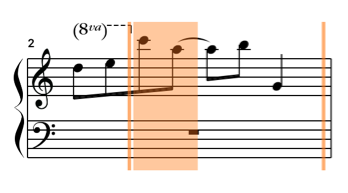Yes, is it possible to draw vertical lines at any point in the score, of any color , line type and line endings, and to remove them when desired. It is just inserting/deleting line objects in the document model at the desired places. The drawback is that this approach requires good knowledge of the document model. Right now I'm busy but in a couple of days I will post some sample code for doing it.
As drawing/removing a pair of markers is a very common need (e.g. to select a portion for playback or other uses) probably it would be useful to add a couple of simple methods for this to the API. But it is necessary to assess what the most common needs may be so that the API be useful and simple. Ideas for this are welcome.
 Orange is the tempo line, blue and green are selection lines. As you can see the selection lines cover only the first instrument. I changed the height of lines from
Orange is the tempo line, blue and green are selection lines. As you can see the selection lines cover only the first instrument. I changed the height of lines from  That's much better.
That's much better.
In my app (which controls Yamaha's digital pianos) the user loads a midi-file for playback and a corresponding musicxml-file is loaded into Lomse score object. Then user can start playback on piano, the program receives playback position from piano via midi-events and moves current playback position in the score using
interactor->move_tempo_line_and_scroll_if_necessary- this works perfectly.Now there is a feature where user can select a portion of the score for practice. When it hits playback button the piano plays the selected portion over and over again (it actually waits for player to push correct keys). The program continues correctly displaying position with the above Lomse function. All good here.
In the original Yamaha application there are two orange vertical lines - one at the beginning and one at the end of the selection. The beat which is currently being played is painted with the orange background.
Screenshot from Yamaha app:
I wonder what are my options to highlight selected portion of the score in Lomse?